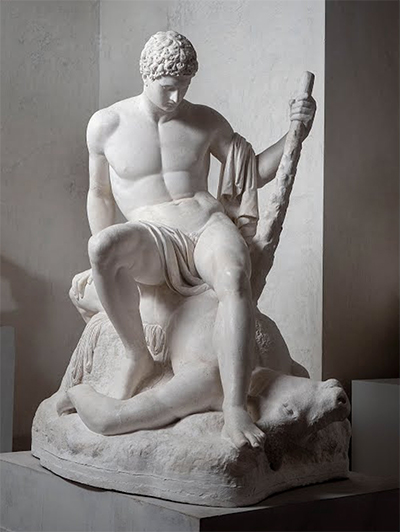Theseus and Minotaur is a sculptor showing a man sitting on a bull-headed monster. Antonio Canova designed and curved it in 1782 from marble. The statue was 145.5 cm long, 158.7cm wide, and 91.4 cm high at the time of creation.
The curving shows domination and trample over evil, an inspiration Canova had when he first thought of the sculpture. The bull-headed beast, Minotaur, was born with human traits. However, its association with humans was disastrous, with casualties dropped along the way. The statute shows Theseus as the liberator of the Greeks after killing the monster.
The inspiration behind this work of art is historical. The mode of dressing depicts the medieval style. Theseus, a Greek warrior, was determined to eliminate this bull-headed Cretan monster. After years of war between the Greeks and Cretans, which results in human sacrifice to Minotaur, Theseus planed to avenge this humiliating defeat. Canova did this sculptor as a visual of how Theseus will look after killing Minotaur. Whether or not it happened, history will validate this imagination.
Neoclassic sculptors were not famous in the 1780s. It might be the first, and among the most celebrated piece of art in its range. The white marbles made it look spectacular, the caption was intentional, and the message was symbolic. It celebrated another Greek hero Hercules, a warrior of repute and saviour of the empire. The statute had various owners after creation but is currently at the Victoria and Albert Museum in London.
Antonio Canova's Works
Sculptures bearing the same message include Hercules and Lichas (1796), Perseus and the Head of Medusa (1806), and Theseus and the Centaur (1819). His other famous works include Orpheus (1777), The Three Graces Dancing (1799), Cupid and Psyche (1793), and Napoleon I (1811). Besides stone making, he was a good painter. His portrait (1792) and Amadeo Svajer (1790) showed his skills.
Canova's skills commanded respect in artistic circles. He was the most celebrated neoclassic sculptor during the 18th and 19th centuries. His talent developed immediately he stepped at the Academy of Arts in Venice. He went on to exhibit at the Feast of Ascension, in Italy and France. His influence helped grow talents like John Gibson and Richard Westmacott. Currently, most of his works are at the Museum of Art and Architecture in Venice.




